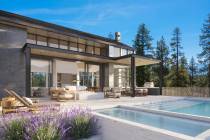Green design doesn’t have to be expensive, challenging
DEAR GAIL: I read a lot about green and sustainable design, but how can I incorporate it into my home? I’m not able to remodel, but would like to do what I can. — Jamie T.
DEAR JAMIE: We all need to be thinking green and sustainable whenever we can. With the world’s population growing and our resources shrinking we have to work together to keep what we have.
For those who do not know what green design is, it is, in simple terms, about producing products that are designed to protect our health and well-being. So, it’s about products that improve our indoor air quality or make our environments safer. Sustainable design is about producing products that meet our needs now but will not compromise the future generations’ ability to meet their own needs. So, it’s about products that conserve energy and protect our natural resources.
Remodeling isn’t in most budgets today and you don’t need to remodel to have a green and sustainable home. But if you are doing a little redecorating there are a couple of things you can do.
One is to use a low- or no-VOC paint. VOC stands for volatile organic compound, which is a highly evaporative, carbon-based chemical substance that produces noxious fumes. By using a low- or no-VOC paint it will help to improve your indoor air quality. You’ll find that just about every paint manufacturer is now producing eco-friendly paints.
A simple thing you can do is when your light bulbs burn out replace them with compact fluorescent bulbs. These give off less heat and are more energy efficient.
When using fabric, look for ones that are eco-friendly. These can be recycled, organic and newer types that break down air toxins, such as cigarette smoke, exhaust, pet odors, adhesives, ammonia and kitchen odors and break them up into water vapor and CO2.
You’ll see a lot of recycled polyester, glass and plastic being made into fabric and they don’t have a rough feel. Organic fabrics are made from natural fibers that have been grown without the use of pesticides in soil for at least three years.
Redesign is being considered the newest green design because you are only using what you already own. This is one of the simplest and no-cost ways to bring green into your design. We all want something new, especially with so many sales in the paper each week, but ask yourself if you really need it. Instead, use what you have and give yourself a whole new look. Simply start by thinking out of the box and moving things around right under your roof.
It’s been said that after about 21 days we no longer really see the things around us. We pass them by without even taking notice, so move them around. Start with your artwork. Take it all down and line it up along the walls. Pick out your favorite pieces and hang them in a new location.
I went to a seminar given by Alexandra Stoddard, a world renowned interior designer, and she does this every six months. She can more than afford new artwork, but she loves what she has, so she moves it around. When I got home I did this myself and what a difference it made. I had been wanted something new, but didn’t need it. I love what I have but just no longer saw it.
Want to bring your family and friends to the green side? Have an accessory exchange party. I’m sure we all have an accessory or two that we’ve had for years, sitting in the same place on the coffee table or one you bought on a whim and it’s still on the shelf in the closet.
For even a more dramatic change, rearrange your furnishings. It’s amazing how many homes I go in that the furniture has been in the same place where the movers put it years ago. Just moving it around will give your room a fresh new look at no cost.
Instead of buying new, recycle what you have at a consignment store. Consign what you have and use the money to buy something that is new to you. Many of the stores actually have brand-new pieces from model homes, World Market Center Las Vegas and store closures.
One last thing, if you’re repainting the exterior of your home, look for a paint that has a high LRV, or light reflectance value. The higher the LRV number, the more light the color will reflect. Chocolate brown with a LRV of 10 is only going to reflect 10 percent of the light and absorb 90 percent, where beige with a LRV of 85, will reflect 85 percent of the light and only absorb 15 percent. So in the summer, a color with a higher LRV will reflect more sunlight, helping keep your home a bit cooler and the power bill a little lower; every bit helps.
Green is all around us. It’s the color of life, growth and Mother Nature. And although green design is not about the color, but about sustaining the life, growth and Mother Nature in our world, we can all bring a little green into our homes.
Gail Mayhugh, owner of GMJ Interiors, is a professional interior designer and author of a book on the subject. Questions may be sent by e-mail to: gail@gmjinteriors.com. Or, mail to: 7380 S. Eastern Ave., No. 124-272, Las Vegas, NV 89123. Her Web address is: www.GMJinteriors.com.


















